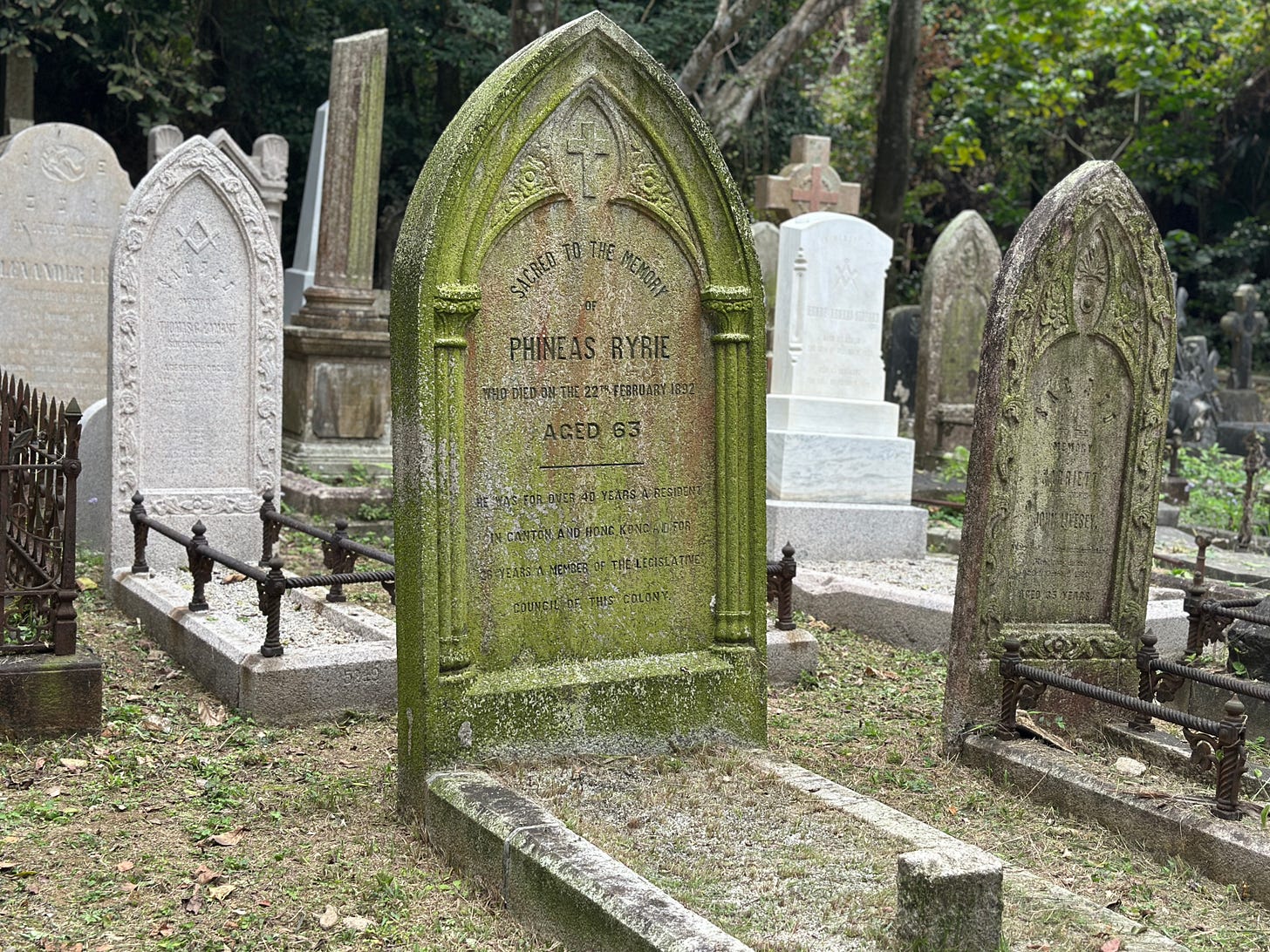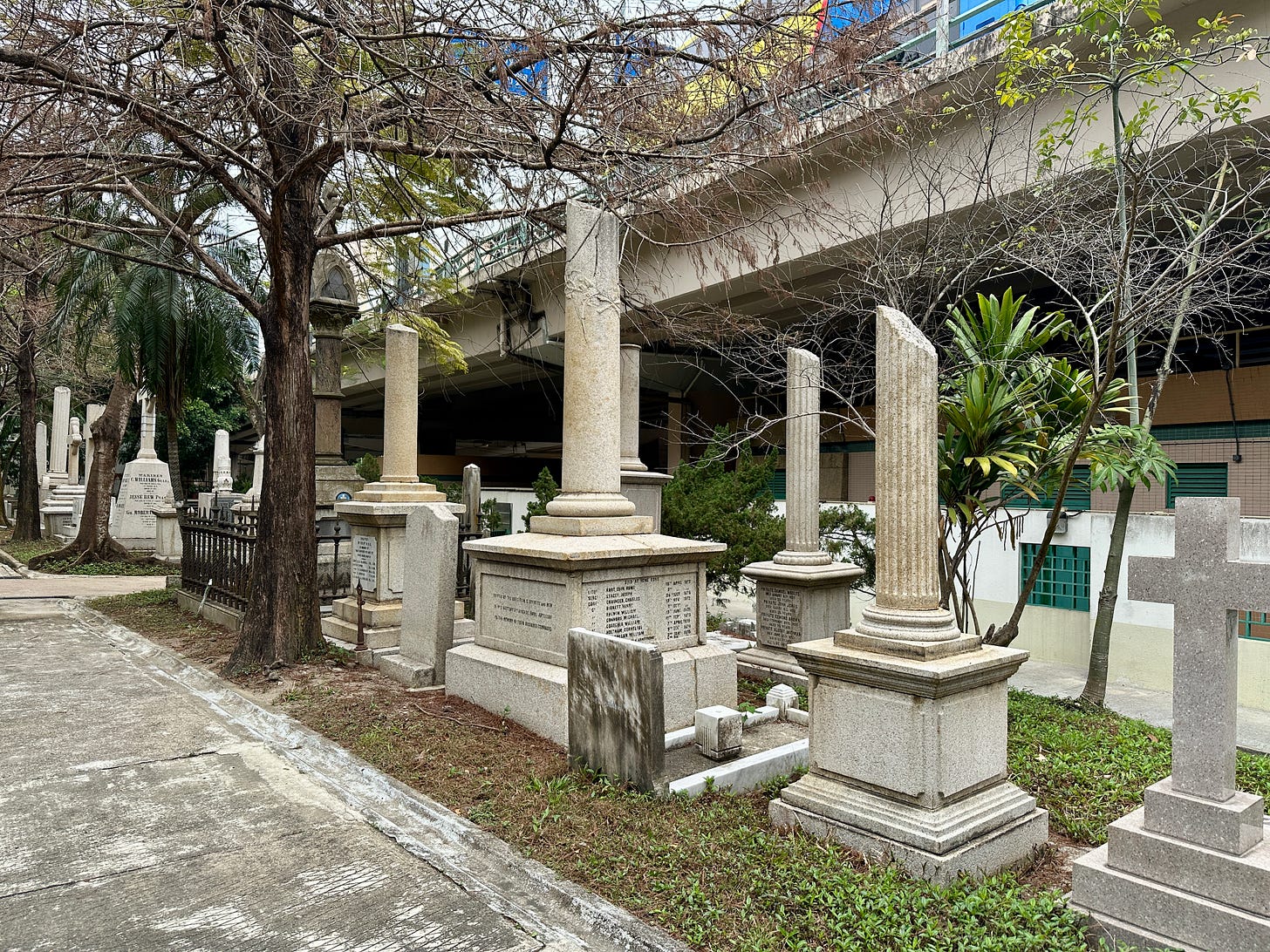Hello friends,
Recently, I spent several days wandering through the Hong Kong Cemetery where my ancestors are buried. The most famous of my ancestors (who deserves an entire book rather than a miserly post) has a fine headstone that, despite its appearance, has recently been cleaned and treated.
Phineas Ryrie was a pioneer of colonial Hong Kong. Even today, it’s hard to imagine that he was born on a remote island in the Scottish Outer Hebrides in 1827. Like many in his family, the ocean unfolded in front of him like a beckoning highway. By his early twenties, he was living it up in Canton and Hong Kong, known as a ‘taipan’ or merchant prince, with his finger in many pies, as Patricia Lim put it beautifully in her seminal book Forgotten Souls.
Phineas founded the St. Andrew’s Society which contributes to the upkeep of his headstone. He was a member of the colony’s Legislative Council for more than twenty years, and had a hand in the establishment of the Jockey Club, Peak Tramways and the Dairy Farm Company.
Phineas’ nephew Alexander, the dude I’ve written about before, fathered three children with my maternal Chinese great-grandmother, Josephine Ryrie Greaves, whose given name was Ng Jo Sing.
At the cemetery, despite a plan and a plot number, it took me hours to find Josephine’s grave. Take a look at the image below. I walked past this several times.
Close by are the graves of her son Alfred, his wife Rose and their son Alexander (Alec).
Josephine’s daughter Winifred’s resting place is in London, where she spent the final decades of her life. Regrettably, there are no surviving graves for Josephine’s youngest son, my grandfather C.K. (Keat) Greaves, or Keat’s wife, my grandmother Elsie. They were both buried in Shanghai’s Bubbling Well Cemetery in the 1930s. The graves were destroyed when the area was cemetary was transformed into a public park.
Perhaps because of this, I have developed an obsession with old cemeteries. I want them preserved as quiet spaces in perpetuity. I love the idea of cemeteries reimagined—like Helsinki’s Plague Park, or stone walls with headstones embedded into them, such as Hobart’s St David’s Park. Cemeteries remind us that time and memory are short.
Saving cemeteries is not a logical or practical exercise. It’s muddied by emotion. Many cities are rapidly running out of burial space (and the money to manage these spaces), like the regional city of Bathurst in Central West New South Wales.
I plan to return to Hong Kong to revisit my Chinese great-grandmother’s grave. Josephine died in her eighties during the Second World War. Hong Kong was under Japanese occupation. How and When was she buried? I don’t know anything about what she was like as a person. My mother used to be scared of her because she was blind, a forbidding character sitting in a dark room, my Mum recalled. Josephine’s grave (and a handful of photos) is pretty much all that speaks of her existence. Unlike my famous great-grand-uncle Phineas, no one will be reviving Josephine’s headstone. Except, perhaps, me.
In cemeteries, we measure what remains—not just stones and names, but the idea of presence. Phineas left behind a legacy etched in the city’s infrastructure and upheld by a long-gone colonial society. Josephine left only silence and a deteriorating grave. Yet both are part of me. I search for remnants of stories whether untold, overgrown with weeds or entirely forgotten. Graveyards are more than burial grounds. They are archives of belonging. And in preserving them, we preserve a little of ourselves.
Thank-you for reading. Here are a few additional photos from my visit. Your thoughts and feedback are welcome.











Great post Jane, such a well-told personal story ... really enjoyed reading this!
Wonderfully written and inspiring….hope to visit my grandfathers grave in Japan, though the cemetery may have been turned into a park??….must find out and get on with research and travel!! Thank you Jane for your lovely letters, cards and sharing family stories. Wish I could write like you!! 🌺🙌🤩🙌😘
Big hug 🤗